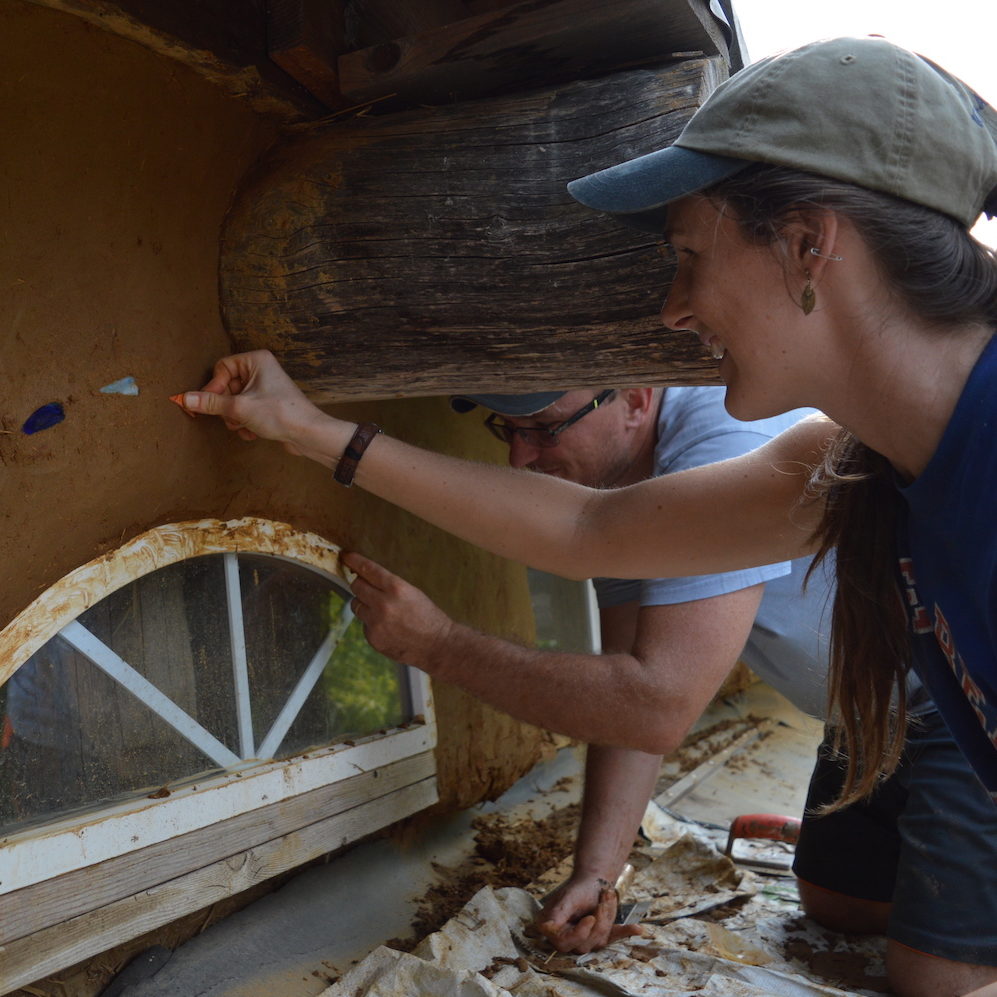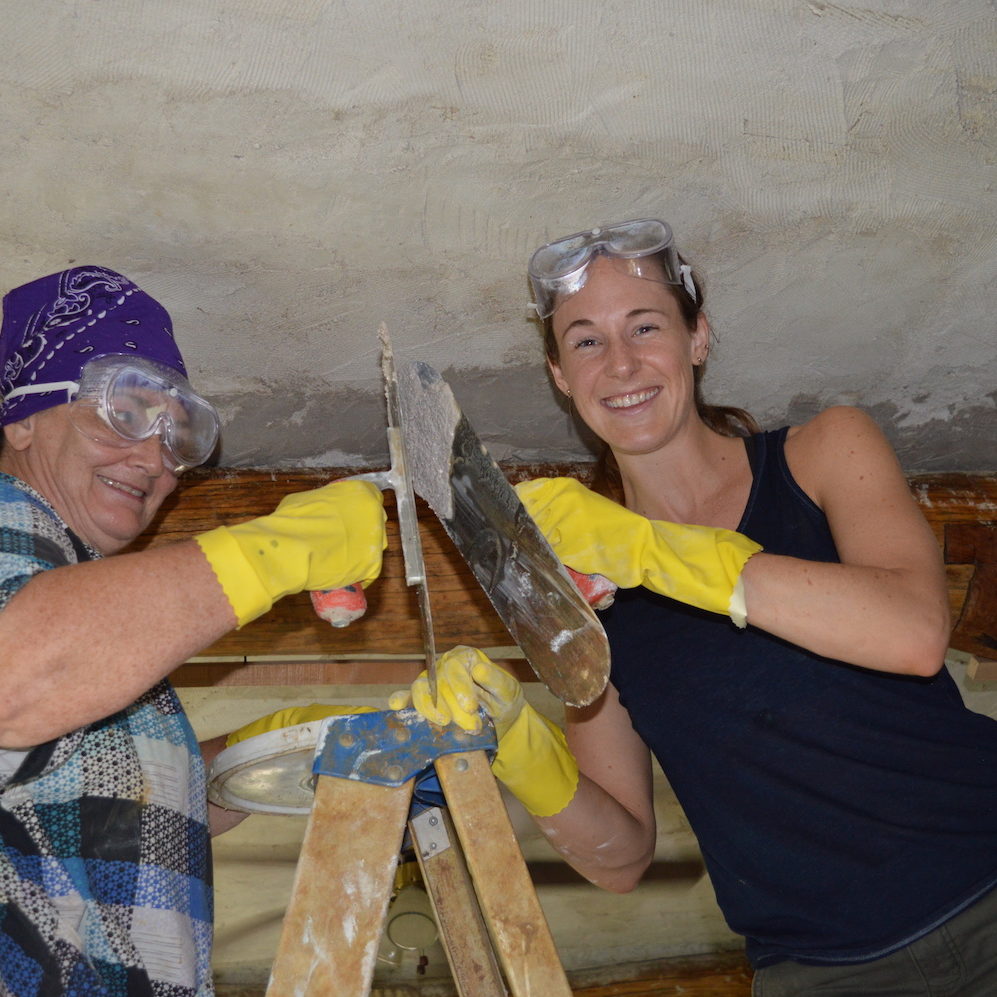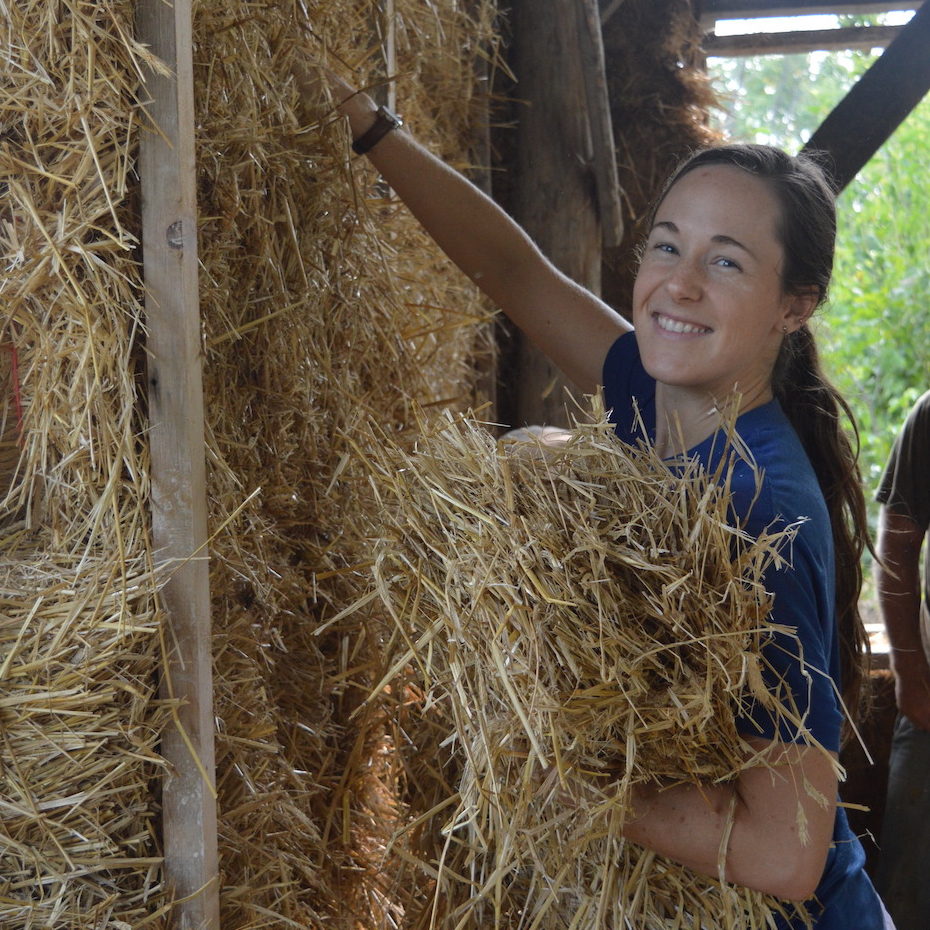Stories from the Mud: My Dancing Rabbit Experience
Published: Sun, 04/21/19

As I drove towards Dancing Rabbit Ecovillage last August to attend the Natural Building Workshop, I was full of anticipation, questions, and even a little bit of fear. Questions like: who else would be attending the workshop? How could 4 days possibly be enough time to learn anything? What would the work be like? Would the food be good? The fear had to do with a dream I’d been harboring: one day building a cozy, beautiful home for myself or my family. What if my dream was beyond my skill or means?
We started with a tour of the village. I had thought there might be a cob or straw bale structure here or there, but I was amazed that almost every dwelling was made with natural materials, and the villagers were kind enough to take the time to share their experiences, including what they would have done differently and why. What struck me most was huge range of possibilities. No two houses were alike. Some were on the “natural” side of the building spectrum, using mostly sand, clay, and straw. Others tended towards the “green” side of the spectrum, allowing for the use of more conventional materials but geared towards long-lasting energy efficiency. It was fascinating seeing examples all across the spectrum, and discussing the pros and cons of each.
Confronted with the range of possibilities for natural and green building, I realized that one of the beauties of these methods is that it’s up to the builders and future dwellers of every home to make decisions about where on this spectrum the building design will be. The essence of people and the essence of their houses are not disconnected, as in conventional building methods. Rather, people are required to tap in to their intuition, principles, and desires, and their home becomes an expression of who they are and how they view their role in their smaller and larger ecosystems. In this sense, “natural” building could more aptly be termed “appropriate” building – making informed decisions about what materials make the most sense to use given the location, climate, resources available, cost, energy needs, distance to material sources, skill level and number of builders, structural goals, etc.

Amy putting artistic elements onto Sharon's house with fellow Natural Building Workshop attendee
One of my biggest takeaways came from the fact that we were encouraged to reframe our thinking that in order to build in the future; we couldn’t just follow a simple recipe like 1 part of this to 2 parts of that, and put it on X inches thick and let it dry for Y number of days. Instead, the best building will result from truly understanding the essences of the materials being worked with. What effect does clay have with its water-loving properties that calls for different amounts to be used in cob vs. plaster? What else can be mixed in to plaster to get the desired textures? (Cow manure and cattail fluff were two add-ins we worked with.) What role does sand play in making cob for walls? (Think tiny bricks.) How does the insulation capacity change when straw bales are reoriented in certain directions? What is it about the chemical makeup and shape of straw that makes it insulative, and why not use hay? Why on earth would we want cow manure to be part of our walls?! What about linseed oil led to its use in earthen floors and how did this original use evolve into what we now call linoleum?
Hassan, the main instructor, really made sure to gear us towards this type of understanding, so that we would be empowered to make informed decisions in a variety of future environments based on an actual connection with the materials being used. It was this aspect of the course that addressed my fear that I may not be able to do this myself one day in the future. I was mostly intimidated that I wouldn’t be able to take what I learned at a 4 day workshop and apply it in a different setting.
Over the course of the weekend, all my questions were answered and more. The other people who attended the workshop were a surprising range of backgrounds and ages, and it was purely delightful to bond with everyone while stomping around barefoot in clay/sand/straw concoctions, transforming a stack of straw bales into someone’s future walls, and scraping plaster onto walls and ceilings with our hands and trowels. Four days of workshops and evening lectures was plenty enough time, the work was a healthy balance of challenging and fun, and the food was delicious, nourishing, and prepared with love.
A few months later, I got my first opportunity to take a step in the direction of learning outside of a workshop context. I went back to Dancing Rabbit to help apply a layer of finish plaster on the inside of Sharon’s house (she was another workshop instructor). This is where the learning curve really stepped in. When mixing the material with (cold!) feet, we wished we could just follow one simple recipe that worked every batch. But we had to tune into things like how long the clay had been soaking and in how much water, if the sand was wet or dry, the size of each cattail, and how long the manure had been “aging”. With awareness of all these factors, we had to make decisions to adjust the ratios of ingredients accordingly. It was the tapping in to this intuition and the trial and error of seeing the subtle variations of each batch in texture, color, stickiness, and thickness, that I started getting more acquainted with the materials.

Amy working on lime plastering inside Sharon's house with fellow Natural Building Workshop attendee
Another major thing I learned was that I (we) will always be learning, that the only way to learn is by doing, and that the best method for doing is with awareness, intuition, and joy (especially when mistakes are made). Who you are becomes what you create, and when it comes to creating a home, who you are and what you create really matters.
I’m currently writing this in New Mexico, where I recently moved into a 200 year old adobe home. I can see little pieces of chopped straw in the walls enclosing me. I can see where hands and trowels shaped the transitions between ceiling, wall, and floor. I can sense that there is story in every floor board, roof rafter, door, and counter top – a story connected to the place and people that made this building come to life. Conventional homes seem to
foster disconnection between people and places in almost every part of the building process; they are usually built by anonymous people with anonymous materials. It’s that story that buildings tell and how building can bind people and places together that drew me to natural building in the first place. Thanks to Dancing Rabbit, especially Hassan and Sharon, I now know it is a story that we all have the capacity to continue to tell as we work for a more beautiful, sensible,
sustainable world.
Do you share Amy’s dream to build a beautiful natural home one day? Don’t wait to make your dreams come true. Take the first step by signing up for a Natural Building Workshop or our first ever Natural Building Internship at Dancing Rabbit Ecovillage.
